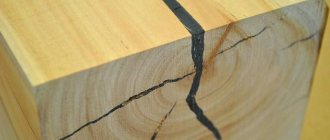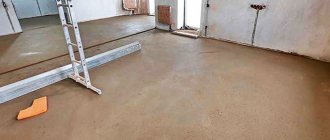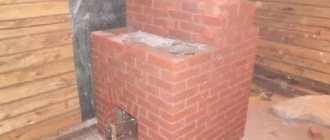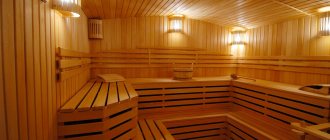Cleaning baths and saunas
Properly treated wood will not turn black for very long. As with any other household premises, cleaning in the bathhouse and sauna can be either regular (at least once a week) or thorough (at least once a month). It makes sense to clean more often only if at least one of the five signs listed below is present:
- Well noticeable dampness
- Stale air
- Unpleasant odors
- Garbage on the floor and shelves (for example, leaves from a broom)
- darkened tree
Any of these signs indicates that the time has come to clean the bathhouse or sauna. And the latter is also a symptom of poor wood processing. Let's talk about all this in a little more detail.
Regular cleaning
Routine cleaning in a sauna or bathhouse is usually limited to cleaning all horizontal surfaces of debris, and it is recommended to pay attention not only to the shelves, but also to the space under them. Your main enemy in this case will most likely be the leaves from the broom - they are the ones who prefer to gather in large quantities in the dark corners of the rooms.
After this, you can start washing the tiled surfaces. Do not forget to wipe them thoroughly after finishing - if water after or during cleaning gets on the surface covered with plaster, then during the next heating you will be provided with a persistent, unpleasant and extremely difficult to remove odor.
Periodically (every few cleanings) a special composition should be applied to all wooden surfaces to protect the wood from blackening. Different mixtures behave differently under high temperatures, and it is this point that you should pay close attention to when choosing. A properly selected composition will allow the tree not to turn black even after several missed cleanings.
If the wooden surfaces do turn black, there is only one way out - sanding followed by treatment with the same composition that is written about next door. Unfortunately, we have not yet come up with enough environmentally friendly means to help restore the tree to its original appearance.
The last thing to worry about during your weekly cleaning is unpleasant odors. Sweat, detergents and other traces of human existence leave traces in the air. To get rid of them, you should first open all the ventilation holes, and then heat the bathhouse to high temperature and pour 0.5-1 liter of cold water onto the floor. The liquid will evaporate, rise up and leave the room through the ventilation, taking with it all the odors.
As for odors, deodorization is always an option. Whether you use such chemicals yourself is up to you, but it is better to leave such products to professional cleaners.
Major cleaning
Keep the bathhouse clean, because it is your health. Major, also known as general cleaning. It differs from the usual one by much deeper cleaning of all surfaces. Only large companies that have all the necessary chemical and mechanical means, specially trained people and, of course, the appropriate equipment, the list of which includes:
- Extractors
- Steam cleaners
- Industrial vacuum cleaners
And this is not the limit. Of course, instead of the equipment listed above, you can use household analogues (for example, a regular vacuum cleaner instead of an industrial one). But we all understand perfectly well that such a deep cleansing effect cannot be achieved. And the goal of a major cleaning is not only to clean the room, but also to eliminate as many possible sources of dirt and unpleasant odors as possible, and only professional industrial chemicals can help here.
So the conclusion from everything said above can be made quite simple. Regularly carry out the usual weekly cleaning of the sauna or bathhouse; if necessary, clean the room additionally, and leave major cleaning to the cleaners.
https://drec.ru/
Sanitary rules
In order to prevent fungal diseases, a set of sanitary, hygienic and disinfection measures are carried out in baths, saunas, and sanitary checkpoints.
Bathrooms and showers must be equipped with hooks and shelves for clothes and bath accessories.
The staff room is equipped with individual lockers for separate storage of personal clothing and workwear of bathhouse workers.
Baths, saunas, sanitary inspection rooms must be provided with a sufficient number of labeled cleaning equipment, separate for all categories of premises. Cleaning equipment must be used in strict accordance with the labeling and stored in a separate room or cabinets.
Rubber hoses should be used for cleaning soap and steam rooms. Every day, after the closure of the bathhouse, sauna, sanitary inspection room, all premises are thoroughly cleaned using detergents and disinfectants that provide a fungicidal effect. During the working day, in breaks between sessions (at least 30 minutes), the bathhouse premises are cleaned using detergents and disinfectants (paying special attention to the floor, benches, basins).
In bathhouses, saunas, sanitary inspection rooms, once a week (it is necessary to have a schedule for closing institutions on a sanitary day), the schedule is agreed upon and approved by the head of the organization. On sanitary days, visitors are not allowed. On this day, a general cleaning of all bathhouse premises is carried out (including the treatment of walls, floors and equipment) using detergents and disinfectants.
Workers of baths, saunas, and sanitary inspection rooms must be provided with protective clothing in an amount that ensures that they are replaced at least once a week and when soiled. Cleaners must also have gloves and aprons.
In baths, for one place in the soap bar there should be two basins (for the body and legs), differing in color or shape, which after use are treated with detergents and disinfectants. Showers must be equipped with smooth rubber or plastic mats (not ribbed). It is possible to use painted wooden gratings.
To prevent foot mycoses, when visiting a bathhouse, sauna, or shower, you should use closed rubber slippers. The use of impersonal shoes is unacceptable. After visiting the bathhouse, the skin of the feet can be treated with a skin antiseptic intended for this purpose and approved for use in the prescribed manner.
Cleaning and disinfection of saunas and baths
To preserve the original appearance of the sauna and hammam for a long time, use professional care products for the premises.
The bathhouse heals the body and soul. But each of its spaces—steam room, dressing room, rest room—contains moisture and steam, high temperature, which allows germs and pathogenic bacteria to settle there for a long time. In a bathhouse, invisible guests multiply quickly. Therefore, it is necessary to properly and regularly clean, clean and disinfect the bathhouse.
The easiest way to clean is with a regular brush of varying hardness and water. The result will be impressive. It is advisable that the brush be in plain sight, and that the last person to steam and wash should use it to wipe the walls, floor, and other wooden surfaces and immediately rinse with water.
With such care, the cleanliness and splendor of the steam room will be preserved for years, and the steam room and washing area will delight you with their readiness for procedures and washing.
But sometimes an unsightly coating or rusty stain appears on the surfaces in the bathhouse. And then it is necessary to carry out disinfection. After carrying out all the necessary work, be sure to wash the brushes, then open all the doors and completely ventilate and dry everything. From us you can purchase all the necessary tools for this.
Bath and sauna care products
These products are mainly represented by well-known brands TYLO (Sweden), SUPI (Finland), HARVIA (Finland).
For cleanliness and polishing of steam rooms in baths, the Tylo “Mega Cleaning” cleaning system is very effective. The results are amazing when cleaning a wide variety of surfaces. This includes any plumbing fixtures, tiles, and plastic. The product is completely environmentally friendly and completely harmless even if there is a child in the house.
To protect wood in a bathhouse, bathhouse impregnations, varnishes, oils and other protective agents are needed. From us you can buy oils for impregnating wood, varnishes for protecting walls. These products will also protect the tree from fungi and mold.
For dirt and moisture we also offer paraffin oil, which meets environmental requirements even when heated. An interesting offer for you would be the semi-matte protective composition Saunasuoja, which, being deeply absorbed into the wood, will retain the original appearance of the wood surface for a long time.
Pay attention to products that dissolve lime salts, suitable for wood, tiles and metal. And SUPI Arctic gives a pearl shade after processing. Harvia detergent is also good for cleanliness in the sauna. The product does not contain harmful substances and is applied to the surface with a brush or sponge. Eliminates foreign odors.
Chimney cleaning products are also on sale. They remove soot and soot and are used for fire prevention. When you visit our website, you can familiarize yourself in more detail with the range of bath, sauna or fireplace care products, view the instructions for use in detail and decide on your purchase.
https://saunaru.com
Reliable company - wonderful results
Disinfecting a sauna is not a pleasant procedure. Considering the use of chemicals, it can be noted that it is also dangerous. However, there is the “Unified City Disaster Service”, whose specialists will quickly cope with this work at a low cost. You won't even notice how it will end. Our price for sauna disinfection services depends on the complexity and volume of work. She is always adequate.
If you need sauna disinfection in Moscow and the Moscow region, order it on the website or by phone. You can find out prices from company employees. If necessary, request a call back.
Cleaning the sauna and bathhouse
Many cottage owners have their own sauna in the house or on the property. Cleaning a bathhouse is a troublesome process that cannot be done effectively alone. Mineral deposits settle on the surface of tiles and plumbing fixtures, metal parts and stone finishing elements become coated, and a humid environment and warm air are a real paradise for fungus and mold spores.
Only regular cleaning of the sauna and pool solves the problem of persistent dirt. Not everyone has the time or desire to devote several hours to cleaning. In addition, even the most scrupulous attitude towards the cleanliness of the bathhouse will not save the owner from the above problems.
Do not despair, because professional cleaning of saunas by specialists guarantees protection against mineral deposits and mold. Cleaning experts are ready to arrive upon the client’s first call to contact number 8 (3462) 389-456.
Features of cleaning in the sauna and bathhouse
Professional cleaning of baths and saunas should be carried out at least twice a month, and the bottom and walls of the pool should be cleaned every few months after draining the water. Regular maintenance of rooms with a humid environment by specialists guarantees long-term operation of the sauna without the need for repairs. That is, by regularly calling specialists, you can save money by eliminating the need to perform expensive repairs.
High-quality cleaning of the bathhouse inside includes the following steps:
- mechanical removal of mineral deposits from surfaces;
- removal of mold and treatment of seams between tiles (the most susceptible place for the formation of fungus);
- disinfection of wet rooms with special means (the composition is not dangerous to human health);
- cleaning and disinfection of showers, locker rooms, and bathrooms;
- cleaning plastic, metal, wood and other surfaces from contamination;
- treating the floor with anti-slip materials;
- bringing glass and metal surfaces that require delicate care into perfect order.
Cleaning the pool is an important step
Bathhouse cleaning also includes pool maintenance. It is recommended to clean the pool bowl at least once every two months. It is more effective if the bottom and walls of the pool are cleaned when the bowl is empty. To do this, the arriving specialists have the necessary equipment to quickly deal with contamination. The brushes will not scratch the tiles, but will easily cope with the yellow limescale deposits on the surface of the tiles.
The second method is to clean the filled pool. There is no need to drain the water for this. The nozzle of a special water vacuum cleaner goes through all surfaces, cleaning them directly under water. For such procedures, professional household chemicals that are safe for human health are used. Devices with special filters remove contaminants from the surface of the water.
Even the most hardworking housewife is unable to cope with the contamination of a bathhouse, sauna or swimming pool. It is much safer to entrust this procedure to the cleaning center specialists, who guarantee the absolute cleanliness of the room.
https://klining-moskva.ru
Why are such events needed?
Disinfection of the bathhouse is relevant, since such premises have the following features:
- humid environment;
- temperature changes;
- abundance of people.
All of the above factors create excellent conditions for the development of pathogenic microbes and fungi. Contact with them and their inhalation into the human body cause serious illness. You should not frivolously hope (as some irresponsible owners do) that the disinfection of baths or saunas is ensured by the alcohol tinctures used by visitors. It is necessary to contact specialists.
What else should you know?
Currently, many people in our country are fans of the joys of bathing and regularly visit saunas. And for everyone, despite individual preferences, cleanliness and hygiene are of equal importance (however, not everyone, unfortunately, thinks about this). After all, a sauna that is not properly cleaned can have a detrimental effect on human health.
Any self-respecting person regularly (once a week or more often) cleans his apartment (house). A bathhouse or sauna also requires constant maintenance of cleanliness and order. And, if you clean it properly, it will not only look beautiful inside and out, but it will also last much longer.
What is needed for this? Nothing special, in general: constant cleaning of dirt, disinfection and maintaining antiseptic conditions. By what signs can you determine that a bath or sauna has not been cleaned for a long time? Firstly, due to the unpleasant smell and feeling of increased dampness in the steam room; secondly, due to unpleasant sensations (scalding instead of warming up). Well, and finally, over the dried leaves from the brooms scattered everywhere.
Any bathhouse needs to be wet cleaned every time after someone has washed in it. And, for example, in a Turkish bath, each visit requires special preparations: the floor and seats are washed with a light soap solution. If you have your own bathhouse, you especially need to know all the features of caring for it.
Complete cleaning is impossible without special degreasers and various types of brushes. Every week, all surfaces in the bath should be washed with neutral soap. If you want the shelves in the steam room to retain their original appearance, they need to be sanded about once a year.
Mold that appears due to very high air humidity is eliminated with bleaching agents. Also, we should not forget that after each use of the steam room, the door to it should be left open for ventilation. If your bathhouse has just been built and has never been used, then you first need to heat it well, but not be in the steam room.
Almost every bathhouse has such a device as a drain ladder, which needs regular cleaning and rinsing. And finally, another thing that plays an important role in maintaining cleanliness is the correct use of brooms and sheets. It should be remembered that birch brooms leave brown stains on the surfaces of the bathhouse, and sweaty sheets leave greasy stains. You also need to remember to periodically clean the stove from dust and dirt using a damp cloth (a soft brush is suitable for removing limescale stains).
If you are the owner of a public bath or sauna, then cleaning here, of course, is more complicated. After all, such baths are used much more often, and many more people wash in them than in home baths. In a public sauna, limescale and water stones often form, as well as mold and mildew. And therefore, regular disinfection is necessary here, which is carried out using special chemicals. Showers, locker rooms, toilets and swimming pools also need regular cleaning.
The bathhouse exists, first of all, to cleanse the human body, and therefore it itself must be kept impeccably clean and fresh.
https://www.ros-uborka.ru/
Ventilation: why is it important?
The ancient Russian bathhouse served more than one generation of the family, but no one thought about additional devices for ventilating the premises. The air changed naturally due to the fact that the outside of the log house was not insulated or covered with decorative trim. Ventilation occurred through the gaps between the crowns. Natural ventilation is also typical for wood-burning brick baths with a stove in the steam room - air exchange is carried out through the chimney.
You can eliminate the processes of rotting in a small bathhouse due to the presence of a window or an open door, as well as excellent draft in the oven - it is enough to ventilate the premises well after washing
When organizing ventilation in the bathhouse, you must consider the following:
- Fresh air entering the steam room should not cause a decrease in temperature.
- When ventilating the steam room, exhaust air containing carbon dioxide must come out.
- The air masses in the steam room should be arranged in layers: hot at the top, at a comfortable temperature on the shelves, cool at the bottom.
Important! The presence of drafts in the room is completely eliminated.
When choosing a bath ventilation method, in addition to the area, the construction material is taken into account. If the building does not stand alone, but is made in the form of an extension to the house, then ventilation should ensure high-quality drying of the premises so that dampness does not enter the living quarters and its walls do not begin to rot. In the steam room, it is worth paying attention to the heat resistance of the walls, since the temperature here is quite high.
Wood is the most common material
In the room attached to the main house, forced ventilation is installed, including it in the general ventilation system of the house. The ventilation duct can be led outside through the roof or wall separately. Or you can connect it to the general house system.
To build a bathhouse, they use wood (timber, logs), brick, aerated concrete blocks , and use frame technology.
Baths built using frame technology or built from brick are equipped with supply and exhaust ventilation and a channel is discharged through the roof or wall. Fresh air is supplied inside using an air duct, ventilation valve or vents in the foundation.
Expert opinion: Afanasyev E.V.
Chief editor of the Stroyday.ru project. Engineer.
We advise you to familiarize yourself with the material - the most serious mistakes when installing a stove in a bathhouse.
Construction of a bathhouse from gas blocks; galvanized pipes or sheets are used to make ventilation ducts. For wooden baths, simple methods of natural ventilation are chosen.
Ventilation vents in block construction
Sauna cleaning: impeccable cleanliness, reasonable prices
Timely and professional cleaning of the sauna is one of the main requirements not only for maintaining external order and comfort, but also for compliance with a number of sanitary and hygienic measures. Due to humidity and high temperature, a favorable climate is created for the development of various pathogenic microorganisms.
And frequent contact of walls, sun loungers and floors with water and steam provokes limescale and the appearance of rust stains. Soap scum, microparticles of sweat, exfoliated skin, accumulation of dirt - these and other components serve as a potential threat to visitors to the establishment if they are not removed in time. That is why cleaning the sauna is intended not only to “bring shine”, but also to protect the health of visitors.
List of main services:
- Removing dirt and various types of deposits (lime, soap, mold) from walls, floors, ceilings;
- Cleaning stoves and stones;
- Disinfection of the sauna;
- Cleaning furniture, loungers, headrests, backrests;
- Replenishment of consumables (garbage bags, paper napkins and towels, soap, scented toilet tablets, etc.);
- Treating surfaces with a protective agent;
- Collection and removal of garbage.
Sauna cleaning frequency
It is highly recommended to carry out wet cleaning (with a brush and plain water) at the end of each day of sauna operation. This will prevent plaque from drying out and dirt from being absorbed into the deep layers of finishing materials. The sauna is cleaned several times a week with soft brushes and a special degreaser, with weekly rinsing with a neutral pH detergent.
The wooden floor grating and plastic foot mats are cleaned and disinfected after each day of use. It is recommended to polish shelves once a year, and thoroughly clean them once a quarter. General cleaning of the steam room is ordered at least once a year (for private facilities with low occupancy), and every 3-6 months for public saunas. Floors are washed daily.
Particular attention is paid to the treatment of the surface around the legs of the sun loungers. If necessary, resort to mechanical cleaning of the floor covering using brushes.
https://www.blestit.ru/
Mechanical method
You can use an ordinary well-sharpened scraper or other convenient sharp object and scrape off soot from every centimeter, but this method requires a lot of physical effort and time. You can also clean off the newly formed soot deposits with a stiff brush after each heating of the bath, not allowing it to penetrate deep inside. Of course, both proposed methods are labor-intensive and not entirely effective - the tree has knots, irregularities, etc., from which it is very difficult to remove soot particles. Using a grinding machine will make the task somewhat easier, but it is not the optimal solution, requiring that the resulting dust layer be washed off with soapy water after using it.
Cleaning baths and saunas
Visits to baths and saunas have always been popular in our country. Bath procedures are not only an opportunity to wash, but also a pleasant way to relax in the company of friends, wash away all troubles and get a boost of energy to implement your plans. A modern bath complex consists of many rooms for various purposes: relaxation rooms, SPA treatments, saunas, swimming pools, showers, technical service rooms. Everywhere must be cleaned regularly.
High humidity in some departments of the complex and sudden temperature changes negatively affect the condition of the premises. The wooden lining of the sauna deteriorates due to high temperatures.
Often visitors use birch brooms, apply various bath products and oils, as a result the wood darkens and greasy stains appear on the walls of the steam room. Constant dampness in showers and pools can lead to mold. Experienced cleaners know these features, so bath cleaning ordered from a cleaning company will be carried out with professional quality and in the optimal time frame.
Cleaning the premises of the bath complex
The human skin in the bathhouse is exposed to external influences, so aggressive chemicals should not be used when cleaning the premises. Among cleaning company specialists, cleaning saunas is considered the most difficult and responsible activity.
To clean wooden surfaces, a steam generator is used, with which you can not only remove stubborn dirt, but also disinfect wooden cladding panels. The edges of pools and shower enclosures are cleaned with special delicate products that do not cause allergic reactions and are easily removed and washed off with water. We use professional detergents from trusted manufacturers.
The following are used indoors:
- multifunctional vacuum cleaners;
- extractors;
- steam generators;
- small mechanization devices;
- professional cleaning products.
When placing an order, a representative of the cleaning company inspects the premises and determines the list of work, depending on the type of cleaning.
Types of work when ordering cleaning in a bathhouse
To maintain sanitary and hygienic requirements at the proper level, routine cleaning is carried out regularly in the premises of baths and saunas.
Daily cleaning includes:
- washing and disinfecting bathrooms;
- washing floors and wet cleaning in the building;
- treatment and removal of dirt in saunas and showers;
- replacement of consumable hygiene products in bathrooms;
- dust removal in dry rooms;
- combating microorganisms in swimming pools;
- garbage removal.
As a rule, a general cleaning of the bathhouse and cleaning of all its premises is necessary twice a month. The list of complex works includes:
- washing tiles;
- removal of mold and unpleasant odors;
- removing rust and limescale from surfaces;
- disinfection (ozonation, ionization) of swimming pools and showers;
- oven cleaning;
- use of a steam generator for wooden products (panels and benches in the sauna, cabinets and furniture in locker rooms and rest rooms);
- cleaning upholstered furniture;
- washing and disinfecting bathrooms;
- vacuuming dry rooms;
- wet cleaning of the building;
- garbage removal.
This list can be expanded at the request of the customer. Cleaning of saunas and baths must be carried out after construction or repair work. For prompt interaction, owners of a bathhouse complex or private clients are recommended to enter into long-term contracts for the maintenance of premises with a cleaning company. We value and respect every client. Experienced and responsible cleaners will quickly and efficiently carry out comprehensive cleaning of a bathhouse or sauna in a house, cottage, or private property.
https://www.capclean.ru
Need cleaning services? Call 389-456 and we will definitely help you!
Chemical cleaning
The simplest and most reliable way to remove contaminants is to use liquid chemical compounds. They are evenly applied to the surface to be treated according to the instructions, and after a while they are washed off along with the dirt. Highly concentrated preparations contain alkaline components that promote rapid removal of soot from surfaces without damaging the wood structure.
Important!
To clean wood surfaces, do not use abrasive-based powders or cleaning products. They can be replaced with neutral degreasing gels.
To quickly clean walls and floors, you can use a mop with a telescopic handle.
No less effective in the fight against soot are chemical sponges impregnated with deep penetration substances. They contribute to the quick and safe removal of the smallest particles of soot and soot that have penetrated the wood structure.
The principle of working with sponges is quite simple: holding the sponge with one hand, clean the surface from top to bottom.
Important!
Chemical sponges quickly become clogged and become unusable, so for high-quality work it is recommended to purchase a sufficient supply of material.
Next, clean water is poured into the container, to which a detergent composition, for example, for washing dishes, or any other degreasing agent is added. The soot is washed off with smooth movements using a soft sponge.











